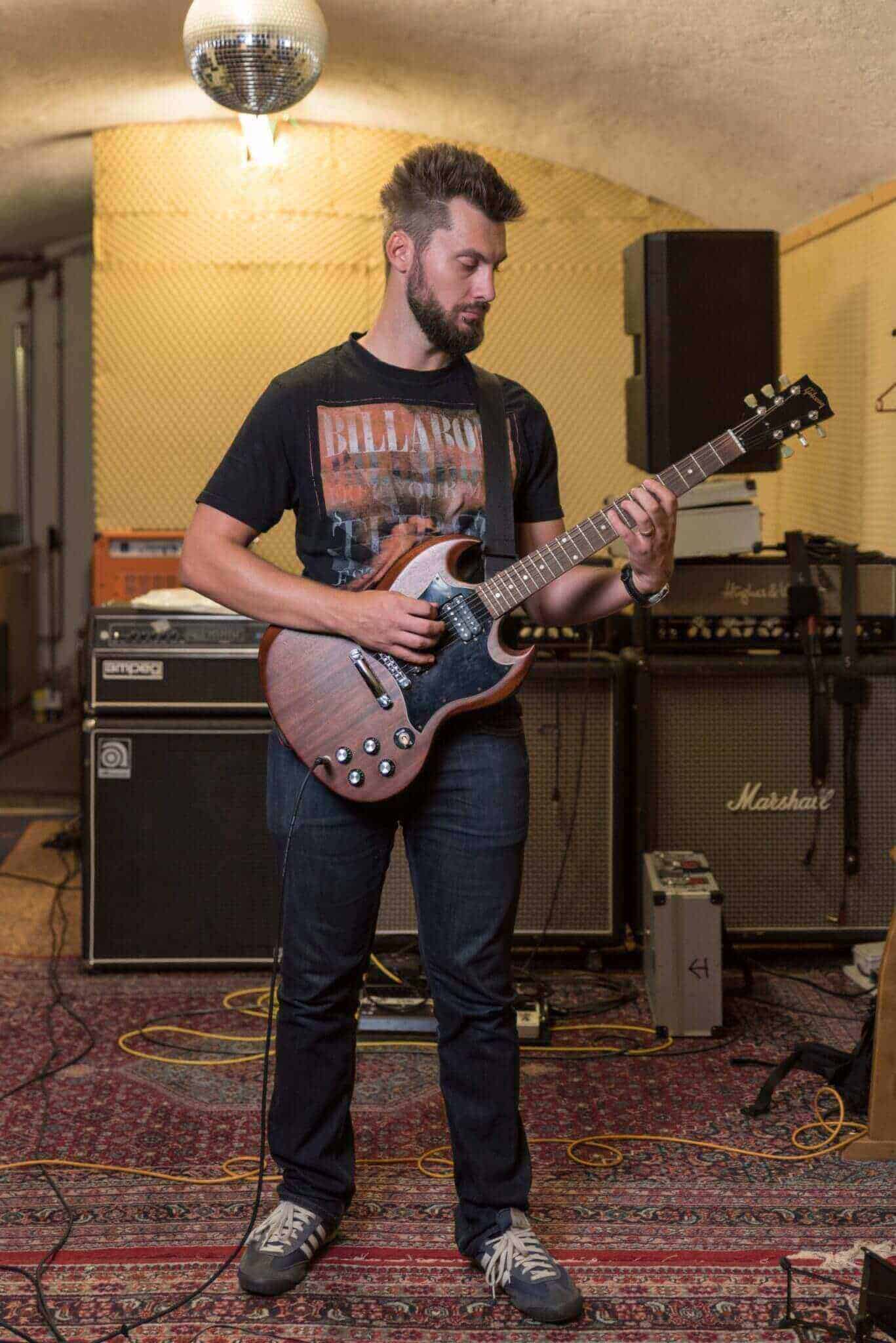We’ve all seen them. Eccentric guitarists who hang their guitar all the way down to their thighs and strum their strings in a low bow. Since we’re talking about professional rock stars, it can seem that this is the best posture to play guitar cleaner and faster. Well, think again! Here's why a proper guitar posture, whether you’re standing or sitting, is fundamental to your success when playing.
Guitar posture when sitting
To optimize your training and to practice as precisely and as efficiently as possible, a correct posture is absolutely essential. Unnecessary tension caused by a sloppy playing position not only restricts the range of your hand movement but also lessens your stamina and accuracy when playing at high speeds/tempos. Do you want ineffective playing positions to limit your potential?

The correct guitar sitting position
- Always use a guitar strap when in a seated position, so that your hands and arms are completely free when you’re playing. A sliding guitar costs strength and accuracy.
- Place the guitar on your left leg in order to allow your playing hand to move to all positions.
- Ideally, raise the leg on which the guitar is resting. This relaxes the foot.
- Only put the guitar only on the right leg if you still can play everything in a relaxed manner.
How to sit in the classic guitar position
While seated on your chosen chair or stool, rest the bottom curve of the guitar on your inner right thigh. Larger acoustic guitars balance near the center of your body in the classic style. The instrument angles towards the right at about forty-five degrees and rests near the top of your left leg.
This proper guitar posture works much easier if you use a short footstool under your left leg. This helps you keep the guitar at the proper angle for easy and comfortable playing. Remember to wear a strap even when seated so your arms and hands can move over the strings freely.
How to sit in the relaxed guitar position
For more relaxed playing, remove the footstool and hold your guitar horizontally across your lap. The bottom curve should still rest on your right thigh. In this guitar pose, the top curve is supported by your left leg instead of your left hand. Again, it makes sense to wear a strap.
Guitar posture when standing

Similar to when you’re seated, you should also put effort in the position of your guitar when standing. This way you avoid any tension and allow your arm to move freely so you can play all pitches on your guitar. When playing in a standing position, you should certainly be using a guitar strap, however, please note the essential following points.
How to play guitar standing up
- The guitar should be hanging quite high. This way your playing hand is flexible and can play many octaves with precision.
- Hold the guitar, so that the neck of the guitar is inclined upward at a 30-degree angle.
- If you prefer to hold the guitar lower, place your foot on top of a box during difficult passages. This allows you to extend your playing hand.
- Vary the height of the guitar only once you’re positive that it won’t affect the quality of your playing. Many guitarists think it looks cool to play the guitar down at their knees, while some of the best play up high near their chest. Most come to a compromise and place their guitar somewhere around the middle, near their hips.
Tricks to getting the proper guitar posture
If you follow all the above tips for proper guitar posture, you’ll save yourself a lot of pain and strain. If you want to maximize comfort and prevent stress injuries, follow the tips found in this helpful video.
Invest in a proper guitar strap
When you have something that weighs several pounds hanging from your shoulder, it makes sense to use a comfortable guitar strap. It needs to hold up under the weight of your instrument without causing pain or irritation. No one can concentrate on maintaining a proper guitar position or making music with a cord or belt digging into their shoulder. The ideal guitar strap should be:
- Strong, with a secure attachment and reinforced stitching
- Made from long-lasting material like leather or woven nylon
- Have a width between 5-8cm to distribute the guitar weight more evenly
Invest in a proper chair
Even if you learn how to play guitar standing up, you’ll occasionally need a comfortable, sturdy chair to take the load off your feet when playing for prolonged periods of time. While you may get stuck with a folding metal chair or hard wooden barstool at a gig, these options will wreak havoc on your body over time. They put stress on your joints, lack any support for proper guitar posture, and can make your rear numb before you even get to your big solo.
Choose a quality, ergonomic chair instead. If you search for these in an ordinary furniture store, you will end up with a bunch of office chairs. These force you into an upright, legs-together position that does not support a solid guitar playing posture. Instead, opt for a padded stool with a back.

Take proper breaks
No matter how absorbed you get in your music, remember to take frequent breaks. Never play for longer than an hour in one sitting. This helps you feel comfortable and energized if you return to playing a little later and will stave off injury due to repetitive stress.
Why striking the right guitar pose is essential
Good guitar posture not only serves the purpose of efficient and accurate guitar playing, but also your health. Tendons and nerves in your fingers and arms, as well as your lower back, are unnecessarily stressed when you position your guitar too low.
As a guitarist, you are responsible to find an optimal and comfortable playing position that works for you. Our advice will help you. After all, it’s our goal to improve your skills and to efficiently and specifically advance your speed. Once you handle your guitar the way John Petrucci, Paul Gilbert, or Kirk Hammett do, no one will bother you about how efficient your playing posture is.
How to advance your guitar skills
As a guitarist, you are responsible for finding the optimal comfortable playing position for you. Let our advice guide you. After all, it's our goal to help improve your skills and to efficiently and specifically advance your speed.
Enjoyed this article?
Here at Fretello, our mission is to make learning guitar easier, and to help people like you to get started. That's why we've created the Fretello Masterclass series. It is a library of content to build your guitar knowledge & skills, exercise sheets to improve and hone your technique, and challenges to most popular riffs and songs. Best thing about it is it's totally free.
Ready for your step-by-step beginner guitar lessons?
As guitarists ourselves, we know that starting guitar can feel overwhelming. But, it shouldn't be. That's why we've created the Fretello Learn Path. With our structured guided lessons, it's simple, fun, and rewarding. Try us out for free and see how much you can improve in a week!